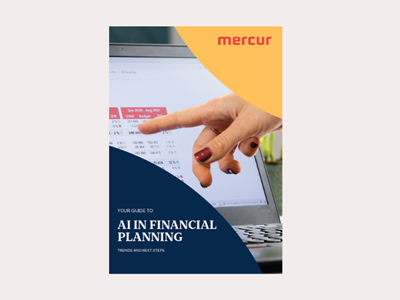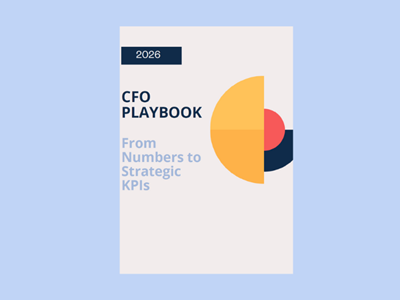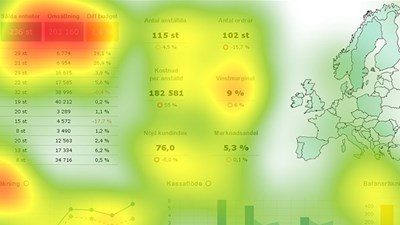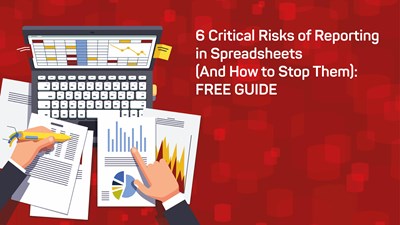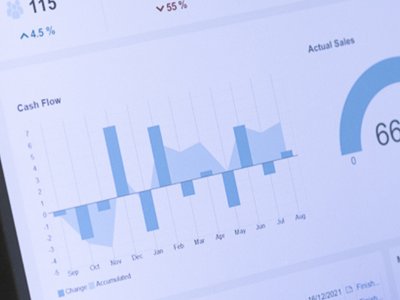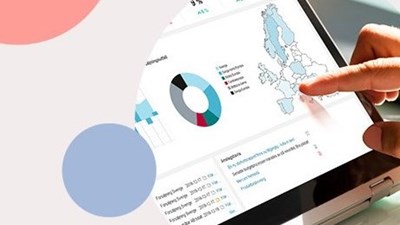.jpg?TS=637208068242104687)
Spreadsheet Risk Management: Best Practices for 2025
Excel has long been a target for hackers; just one click on a malicious attachment can infect your entire network. Yet despite these dangers, spreadsheets remain a core component of many organisations’ documentation processes, supporting critical business functions. Their familiarity keeps them in use, even at the expense of security oversight.
So, how can you keep using spreadsheets while not sacrificing your safety? Continue below for a list of the most common risks associated with spreadsheets and ways to mitigate them.
What Causes Spreadsheet Risks?
Spreadsheet risks arise because they can be expanded indefinitely, making it difficult to track changes, especially when your budgeting process lives inside those very same worksheets. Most organisations administer good practices within their ERP environment, such as applying segregation, identity and access management layers, yet they lose that discipline when data is extracted and uploaded into a spreadsheet.
The vulnerability of spreadsheets has been well documented over the years. The European Spreadsheet Risk Interest Group (EuSPRIG), an independent organisation, publishes on its website examples of disasters and mishaps originating from spreadsheets.
Top Spreadsheet Risks to Look Out for
Here is a list of the most common risks associated with spreadsheets:
Human Error and Manual-Process Risks
Like most programs, using spreadsheet software is a manual process. This means calculations are susceptible to human error. The most common is keying the wrong numbers, deleting formulas, not linking new fields or a failure to update formulas.
Formulas are unique and have specific tasks, as there is no automated process to check for worksheet errors; checking these files is an onerous but important task to prevent errors from happening. Regular auditing and checking of spreadsheets will prevent the need to rebuild the work from scratch.
Security Vulnerabilities and Malicious Threats
High-profile cases have made the headlines in recent years because of spreadsheet security risks. This has at least prompted organisations to develop proper procedures for spreadsheet development, and policies and guidelines do go some way to mitigating risks.
However, threats posed by viruses, Trojans and unencrypted USB sticks are still prevalent, and organisations must be vigilant. Security features such as password protection, hiding or protecting sheets and other features are not actually designed to secure information and can be easily bypassed.
Even with security measures, the threat of hacks is constant. Many organisations are not aware that software is readily available to crack passwords or open spreadsheets and remove all perceived protection features, such as hidden sheets.
Note: One of the best‑known spreadsheet viruses, Malissa, surfaced in March 1999. It spread via malicious macros in Office documents, emailing itself to every contact in an infected user’s Outlook list.
Unsecured Employee Devices
Personal devices that employees bring to work must also be considered for security protocols, or businesses should maintain all data on local servers and allow remote access only to approved employees.
Viruses are also widely transmitted by spoofing methods that include file names like “unpaid invoice,” “overdue invoice,” and similar terms in an email. These phishing approaches try to manipulate unsuspecting users into opening the attachment.
Real-World Case Studies of Spreadsheet Failures
In 2016, Lazard Ltd, the investment bank that advised SolarCity Corp on its $2.6 billion sale to Tesla Motors, made an error in its analysis that discounted the value of the solar energy company by $400 million. The error was the result of a computational error in SolarCity spreadsheets, which it used in its discounted cash flow valuation analysis. The error meant severe reputational risk for the company's advisers.
The high street retailer M&S fell victim in 2016 to a spreadsheet summing error, which forced the retailer to issue a correction to its quarterly trading statement. The original statement issued at 7 am reported group sales had grown 1.3%. But later the same day, the company reissued the financials with a correction showing that group sales had in fact fallen 0.4%. The error resulted in reputational risk and restatement.
Future Business Impact of Spreadsheet Risk
Spreadsheets start with a few formulas but grow and end up being core documents that support business-critical decisions. As the company grows, the worksheets become more complex and harder to manage, by which point it will be too difficult to move to a different reporting tool, so the business sticks with the risky spreadsheet.
From human error to complex equations, formulas and macros, spreadsheets add risk to a company's reporting efforts. They should be replaced by tools that prevent employees from cutting and pasting critical information incorrectly, encourage collaboration and align with current business security protocols.
Now, let’s discuss how to manage spreadsheet risks.
Mitigation Strategies and Best Practices
The widespread use of spreadsheets across businesses of all sizes can make it easy to overlook the potential risks they can pose. Companies that follow these best practices will ensure they are less vulnerable to spreadsheet risks:
Formal development procedures: Treat spreadsheet creation like an IT project.
Access controls: Apply the same identity and segregation policies as ERP.
Regular audits: Schedule recurring checks to catch errors early.
Device management: Enforce security on personal and company devices.
Governance ownership: Finance leaders must champion the adoption of safer reporting solutions. Secure alternatives to spreadsheets can prevent a lot of financial and security problems down the line.
Download Mercur’s Free Risk Guide
Finance Managers, Directors and CFOs are responsible for risk identification and are also in charge of driving the adoption of more suitable IT solutions for reporting. If you would like to find out more about how to keep your organisation safe from spreadsheet risks, get a complimentary copy of Mercur’s e-book about the six critical risks of reporting in spreadsheets and how to stop them.
Frequently Asked Questions
What are the top disadvantages of spreadsheets?
Spreadsheets risk security due to manual errors, a lack of strong controls and scalability issues.
When not to use spreadsheets?
You should avoid spreadsheets for complex, collaborative or high‑security reporting.
How do I protect data in spreadsheets?
Protect spreadsheet data using strict access controls, version history, encryption and regular audits.
You may also be interested in
 Blog
BlogZero-Based vs. Incremental Budgeting
Budgeting sits at the heart of sound financial management. This is why choosing the right technique is crucial for CFOs – it shapes resource allocation, cost control and strategic agility. Incremental and zero-based budgeting are two leading methods that offer distinct approaches.
 Blog
BlogWhat is Corporate Performance Management? (CPM)
CPM, or Corporate Performance Management, is a process within corporate management aimed at measuring and optimizing the performance of an organization. CPM encompasses a range of activities, including budgeting, planning, forecasting, reporting, and analysis.
 Blog
BlogBuild Long-Range Planning for Business Success
Discover how effective long-range planning aligns strategy, finance and operations for smarter decisions and sustainable growth.
 Blog
BlogA practcial guide to scenario planning
Scenario planning gives you a clear, practical way to test assumptions, spot risks and opportunities, and make better strategic choices so your organisation stays resilient when conditions change.
 Blog
BlogTop PowerBI Alternatives in 2025
Explore the top PowerBI alternatives for 2025. Discover how Mercur delivers integrated planning, budgeting and reporting without the high cost and complexity.
 Blog
BlogScenario Planning - Better control during uncertain times
Uncertain times create the need for more frequent forecasts and time for analyzing and comparing different future scenarios. We give you 5 tips on how to simulate future scenarios using scenario planning
 Blog
BlogInformed Business Decisions at Maximum Velocity
The ability to process information swiftly is essential. If your business can’t manage your data efficiently, your company’s financial performance will surely underperform. At Mercur we have developed our own database Veloxic which helps Financial Planning and Analysis.
 Blog
BlogWhat is management reporting?
Management Reporting refers to the process of creating, analyzing, and presenting information about various aspects of an organization's performance to enable decision-makers to make well-informed decisions about the future.
 Blog
BlogTop 7 Manager KPIs for Financial and Operational Success
In today's post we'll break down why KPIs matter, which ones offer the most insight for finance and executive teams and how to ensure they're actually driving results.
 Blog
BlogAI in Financial Planning: Trends and Next Steps
Discover how finance teams are using AI to drive smarter planning, faster insights, and stronger business decisions.
 Blog
BlogWhy is our Excel-based budget always out of date?
Excel creates outdated budgets. Every time someone enters a figure, sends a file, or waits for another department to finish their section, your budget falls further behind reality.
 Blog
BlogWhat Is FP&A? Definition, Purpose, and Best Practices
Without solid financial planning and analysis (FP&A), businesses operate in the dark. In this post we go deeper into the process of FP&A and why it’s important for businesses.
 Blog
BlogHow can AI help CFOs make better decisions?
Artificial Intelligence (AI) has significant potential to enhance decision-making for Chief Financial Officers (CFOs) by providing data-driven insights, automating routine tasks, and enabling more accurate forecasts.
 Blog
BlogAI and Machine Learning, what is it, and why is it important for the future?
Artificial Intelligence and Machine Learning, what is it, and what is the difference?
 Blog
BlogBusiness Intelligence Reporting For Finance Teams
The real challenge today isn’t collecting data, it’s making sense of it and fast. Organisations turn to business intelligence (BI) to convert raw data into insight.But how do you actually do it right?
 Blog
BlogCFO Playbook - KPIs for 2026
The role of the CFO is changing fast. Today, the finance function is expected to deliver more than reports — it must drive direction, speed and profitability through clear, actionable KPIs. Learn more in this guide.
 Blog
BlogSpreadsheets are not Collaborative Tools
Spreadsheets were never designed for collaboration, yet they are the single most used program among teams and co-workers. They often start out as a quick document for storing, formatting or calculating information but evolve into important documents and are often the core records for an organisation.
 Blog
BlogBoost Report Readability, Engagement, and Decision-Making
In today’s fast-paced business environment, effective reports and dashboards are crucial for decision-making. Our user study using eye-tracking technology revealed seven key insights into what captures attention.
 Blog
BlogAI in Finance as a Powerful Tool
In this post, we explore how AI is evolving from a theoretical concept into a valuable resource for decision-making. Get useful insights for finance teams at any stage, from early exploration to actively using AI-powered solutions.
 Blog
BlogBetter Revenue Planning
Sales forecasting is the process of predicting future revenue based on past data and trends. Read the blog to learn the best methods to do it right.
 Blog
BlogHow to succeed with your planning, budgeting, and forecasting process
We know it can be challenging to succeed with your planning, budgeting, and forecasting process. Therefore, we have gathered our best tips for you to succeed!
 Blog
BlogMastering Spreadsheets
Where many businesses start small, a simple spreadsheet can adequately perform the limited tasks required of it. As the company grows, your spreadsheets can get more complex and harder to manage, by which point it feels like it will be too difficult to move to a different reporting tool.
 Blog
BlogHow EPM Transforms Financial Planning and Forecasting
Struggling to keep plans aligned in a changing market? Discover how EPM helps finance teams move faster, stay accurate and lead with real-time insights.
 Blog
BlogAI in corporate budgeting
Artificial Intelligence (AI) can support decision making in key areas such as budgeting, capital allocation and even corporate strategy and as a result, it is increasingly being deployed in corporate performance management tools (CPM).
 Blog
BlogBusiness Budgeting Software: How to Choose the Right One
Choosing budgeting software is partly a finance and partly a strategic decision. The right tool helps organisations organise planning cycles, adapt as the market changes and increase accountability across departments. But not every platform will be a good fit.
 Blog
BlogVariance Analysis: A Comprehensive Guide
Senior executives are demanding more detail in their management reports. The amount of data available to finance departments has exploded and decision makers see this as an opportunity to get more insight into how the business is performing.
 Blog
BlogWhy xP&A is a powerful game-changer
The newest iteration of planning, analysis and reporting systems is a powerful game-changer that unites company departments and boosts competitiveness. It’s called xP&A – the abbreviation of extended financial planning and analysis.
 Blog
BlogWhat Is Planning, Budgeting and Forecasting?
Planning, budgeting and forecasting are rarely static. Shifts in the industry often require you to revisit assumptions, adjust targets and adopt new processes. Learn how to strengthen your approach and stay ahead of change.
 Blog
BlogSpreadsheets Risk the Future of the Business
Spreadsheets often start as just a list for storing information and there is minimal process documentation, support or maintenance for these worksheets. Despite the fact that desktop applications such as Microsoft Office are included in the standard configuration of users' PCs, very little formal training is ever given to spreadsheet users.
 Blog
BlogHow to Effectively Budget with Driver-Based Forecasting
Traditional models of forecasting rely on historical data and beliefs. It uses techniques that identify patterns, which are simple to use. However, with these methods, there are some challenges because they are not dynamic with today’s market, and can’t effectively analyse complex data.
 Blog
BlogBest Guide to Improve Your Revenue with Flexible Budgeting
Optimise your expenses with flexible budgeting, and learn how to adjust budget to reflect current business activities, market changes and cost fluctuations.
 Blog
BlogManagement Reporting Guide: Definition and Tips
Management reporting helps you see what’s really happening in your business. In this guide, we’ll explain what managerial reporting looks like and share practical tips.
 Blog
Blog3‑Statement Model for Better Financial Forecasting
Financial forecasting is critical for any business that wants to adapt to change. But finance teams keep usingfragmented models and manual processes. The 3-statement financial model is the solution.
 Blog
BlogTop-Down vs Bottom-Up Budgeting
Budgeting aligns resources with strategic goals, and there are two primary approaches: top-down and bottom-up. Which method wroks best?
 Blog
BlogThe Business Benefits of Integrated Business Planning
This blog explores what IBP is and the typical IBP process. We highlight business benefits and how the right software can be a game-changer for your organisation.
 Blog
BlogThe Collaborative, Smarter Budget
In many organisations manual budgeting processes over-burden staff and create masses of data which overwhelms department heads and stops them seeing the bigger picture.
 Blog
BlogFive tips for a successful budget process!
How can you make your budget process more successful and maximise the effort that was invested in creating it? Of course, there are many factors to consider but we’ve chosen to highlight five key areas that will enable and help you create a smoother, value-creating and collaborative budget process.
 Blog
BlogBudgeting in a modern world
Thirty years after its debut, Microsoft Excel is still the preferred tool for budgeting and planning projects. However, its popularity is declining, due in most part to the rise of technology and subscription-based pricing for a myriad of SaaS-based products.
 Blog
BlogHow Automated Reporting Will Transform FP&A in 2026
This article highlights the power of report automation, how to implement it in your business and explores any new opportunities for accurate financial analysis in the long run.
 Blog
BlogFP&A Trends Shaping Financial Planning in 2025
Many organisations cope with fragmented planning and data quality issues, which slow down their forecasting cycles. This forces organisations to take practical steps to turn ambition into execution.
 Blog
BlogSave time and create a successful budget process
If you’re working in a large organization, you’re probably aware of how time-consuming the budget process can be. In this article we’ll give you tips on how to save time and still create a successful budget process
 Blog
BlogBalancing Profitability and Sustainability
Sustainability has become a central concern for organisations across the world — and the UK is no exception. This evolving landscape places new demands on financial reporting.
 Blog
BlogRisks with working in spreadsheets
Spreadsheets are an essential tool for all types of organisations and businesses rely on them heavily, particularly for financial computations. The most popular spreadsheet program globally is, of course, Microsoft Excel, it’s used by an estimated 750 million people.
 Blog
BlogRolling Forecasts: Practical Steps, Benefits, and How to Get Started
Financial planning has changed. Traditional annual budgets can’t keep up with rapid shifts in the market, evolving customer needs, and internal performance dynamics. That’s why many finance teams are turning to a rolling forecast model.
 Blog
BlogThe Role of the CFO: Top Priorities and Responsibilities
Today's finance leaders steer more than just budgets and reports. The digital transformation ramps up with the increase of corporate complexity, and so does the role of CFOs.
 Blog
BlogHow do finance teams track KPIs across the entire organisation?
Learn how finance teams track KPIs across the entire organisation by consolidating data from multiple sources into a unified system like Mercur.
 Blog
BlogCash Flow Forecasting
Inaccurate cash flow forecasting can be a costly mistake for companies. In today’s volatile market, relying on static annual budgets or manual spreadsheets leaves financial leaders without the agility to respond to uncertainty.
 Blog
BlogHow To Create a Successful Budgeting Process
When done well, budgeting helps organisations stay financially on course, even when things don’t go exactly as planned. Learn how to keep things on track so you avoid surprises and stay focused on your goals.
 Blog
BlogFrom static budgets to agile financial management
Traditional budgeting has long been the cornerstone of financial planning in businesses. But today it can become more of a limitation than a strength. That’s where the concept of Beyond Budgeting comes in.
 Blog
BlogHow to get accurate financial reports without waiting for month-end
You don't need to wait until month-end to see accurate financial reports. With modern financial systems you can access up-to-date reports whenever you need them.
 Blog
BlogThe Powerhouse of EPM Tools
A business’s success heavily relies on having a strong strategy. However, what's even more important is implementing that strategy while tracking and measuring the performance. This can easily be done by investing in enterprise performance management (EPM) software.
 Blog
BlogThe Hidden Cost of Data Silos
If you ever feel like your teams speak different languages when it comes to data, it is a classic symptom of data silos. The information gets stuck in one department, system or tool, making it difficult for anyone to see the full picture.










